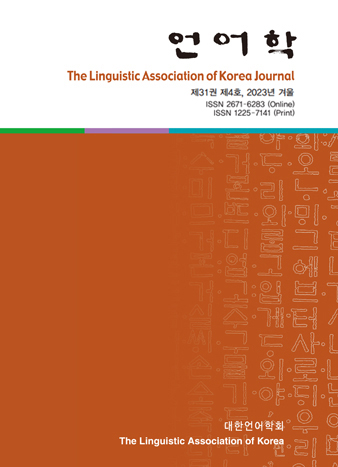대한언어학회 전자저널

31권 4호 (2023년 12월)
- A Socio-historical Study of Vowel Raising in Australian and Canadian English
-
Hak-Moon Lee
Pages : 137-152
Abstract
Lee, Hak-Moon. (2023). A Socio-historical study of vowel raising in Australian and Canadian English. The Linguistic Association of Korea Journal, 31(4), 137-152. This study presents a comparative analysis of Australian English (AE) and Canadian English (CE) related to Vowel Raising in a socio-historical aspect. AE and CE differ in many ways. In particular, among the characteristics of CE, Canadian Raising (CR) is relatively well known for its difference in pronunciation due to the influence of the Great Vowel Shift (GVS). However, little research has been done on whether there is a similar vowel raising in AE, and it is linguistically meaningful to identify the differences by considering the characteristics. In particular, among many differences, when pronouncing the vowel in Price when a voiceless consonant comes after a diphthong, the CR phenomenon occurs in Canadian English compared to American English or British English. Through the comparison and analysis, we investigate whether the CR phenomenon is occurring in Australia, a commonwealth country. If the differences between AE and CE, which are the mother tongues of the world Englishes, are recognized, it will be evident that students benefit a lot from them.
Keywords
# CR # GVS # Canadian English # Australian English # American English # diphthongs
References
- Antonia Andreu Nadal. (2016). A Comparative analysis of Australian English and RP monophthongs. University Autonom de Barcelona.
- Cox, F., & Fletcher, J. (2017). Australian English pronunciation and transcription. Melbourne: Cambridge University Press. Cross RefGoogle Scholar.
- Cox, F., & Palethorpe, S. (2007). Australian English. Journal of the International Phonetic Association, 37(3), 341-350. CrossRefGoogle Scholar.
- Cox, F. (1999). Vowel Change in Australian English. Phonetica, 56(1-2), 1-27. http://doi.org/10.1159/000028438
- Cox, F. (2006). The acoustic characteristics of /hVd/ vowels in the speech of some Australian teenagers. Australian Journal of Linguistics, 26(2), 147-179. CrossRefGoogle Scholar.
- Cox, F. (2011). Australian English Pronunciation and transcription. Cambridge: Port Melbourne, Vic: Cambridge University Press.
- Cox, F. (2006). The acoustic characteristics of /hVd/ vowels in the speech of some Australian teenagers. Australian Journal of Linguistics, 26(2), 147-179.
- Cox, F., & Fletcher, J. (2017). Australian English pronunciation and transcription. Melbourne: Cambridge University Press.
- Cox, F., & Palethorpe, S. (2007). Australian English. Journal of the International Phonetic Association, 37(3), 341-350.
- Cox, F., & Palethorpe, S. (2011). Timing differences in the VC rhyme of standard Australian English and Lebanese Australian English. Proceedings of the 17th International Congress of Phonetic Sciences (ICPhS XVII), Hong Kong, China, 528-531.
- Cox, F., Palethorpe, S., & Bentink, S. (2014). Phonetic archaeology and 50 years of change to Australian English /i˘/. Australian Journal of Linguistics, 34(1), 50-75.
- Cox, F., Palethorpe, S., & Miles, K. (2015). The role of contrast maintenance in the temporal structure of the rhyme. Proceedings of the 18th International Congress of the Phonetic Sciences (ICPhS XVIII), Glasgow, UK, 1–4.
- Horvath, B. M. (2008). Australian English: phonology. In: K. Burridge & B. Kortmann, eds. Varieties of English 3: the Pacific and Australasia. Berlin: Mouton de Gruyter, pp. 89-110.
- House, A. S. (1961). On vowel duration in English. The Journal of the Acoustical Society of America 33(9), 1174-1178. CrossRefGoogle Scholar.
- Mitchell, A. G., (1946). The pronunciation of English in Australia. London, England: Angus and Robertson.
- Mitchell, A. G., & Delbridge, A. (1965). The pronunciaton of English in Australia (revision of Mitchell 1946). London, England: Angus and Robertson.
- Moore, B. (2004). The Australian Oxford Dictionary. 2nd ed. Oxford: Oxford University Press.
- Peterson, G. E., & Lehiste, I. (1960). Duration of syllable nuclei in English. The Journal of the Acoustical Society of America, 32(6), 693-703. CrossRefGoogle Scholar.
- Ratko, L., Proctor, M., & Cox, F. (2022). Articulation of vowel length contrasts in Australian English. Journal of the International Phonetic Association, First ViewPublished online by Cambridge University Press: 05 May pp. 1-30.
- Ronowicz, E., & Yallop, C. (Eds.). (2007). Australia- The Great South Land. In English: one language, different cultures (2nd ed. pp. 79-128). Loondon; New York: Continuum.
- Rogers, H. (2000). The Sounds of Language: An Introduction to Phonetics. Essex: Pearson Education Limited. ISBN 978-0-582-38182-7.
- Trudgill, P., & Hannah, J. (2007). International English: a guide to varieties of Standard English (4. ed., [Nachdr.]). London: Hodder Arnold
- Watson, C., & Harrington, J. (1999). Acoustic evidence for dynamic formant trajectories in Australian English vowels. The Journal of the Acoustical Society of America, 106(1), 458–468.
- Wells, J. C. (1996). Beyound the British Isles (Reprinted). Cambridge: Univ. Press.
- Yallop, C. (2003) A.G. Mitchell and the Development of Australian Pronunciation. Australian Journal of Linguistics, 23(2), 129-141.
- https://academic-accelerator.com/encyclopedia/kr/canadian-raising
- https://namu.wiki/w/캐나다%20영어
- https://www.oed.com/information/understanding-entries/pronunciation/world-englishes/
- https://en.wikipedia.org/wiki/Canadian_raising
- http://doi.org/10.1080/07268600032000203146